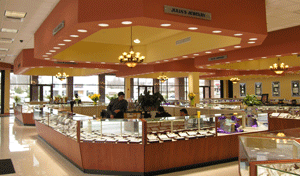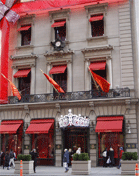Is a Piece of the Good Life Hurting?
Sales of luxury goods in the U.S. are expected to total $72.5 billion in 2008, according to Bain & Co., a Boston-based retail consulting firm. Worldwide, sales of luxury goods are expected to grow 3 percent this year to $230.7 billion, Bain predicted last October. That is down from growth of 6.5 percent last year and 9 percent in 2006.

The jewelry industry is one of the indispensable parts of luxury goods. The US jewelry manufacturing industry includes about 1,900 companies and the 50 largest firms account for 60 percent of industry revenue. However, nearly two-thirds of companies have fewer than five employees.
Consumer confidence in the luxury market dropped in the third quarter to its lowest level since Unity Marketing began tracking it in December 2003, but according to the Elite Traveler - Prince & Associates, about three-quarters of families with a net worth of $1 million to $10 million said in a survey that they would spend less in the final three months of this year than last year on luxury items. Less than 1 percent said they would spend more. 58 percent of survey participants said they planned to spend an average of $2,400 for jewelry and watches.
INDUSTRY OUTLOOK
In 2006, there were nearly 1,700 manufacturers of precious metal jewelry in an industry with over 32,000 employees. The U.S. had 15 percent of the worldwide sales in this category. Manufacturers face steadily rising costs in precious metals and jewels, especially diamonds. The value of shipments grew from $5.26 billion in 1998 to $8.62 billion in 2003. Industry revenue for 2005 was approximately $7.18 billion, with a gross profit of 33.16 percent, or $2.38 billion.
According to the report prepared by Global Markets Direct, the industry's revenue for the year 2007 was approximately $9.7 billion USD, with an estimated gross profit of 27.45%. Import was valued at $32.6 billion USD, from 160 countries. The industry also exported $19.0 billion USD worth of merchandise to 166 countries. Adding import value to and subtracting export value from the industry's shipment value, the total domestic demand for the industry in 2007 was $23.3 billion USD.
According to the U.S. Census Bureau, jewelry, watch, precious stone, and precious metal wholesalers represented approximately 12,936 establishments in the mid-2000s. Combined, they employed some 61,411 people with an annual payroll of $2 billion, most of whom worked in New York, California, and Texas.
The total number of employees reached 61,411. The average sales per establishment were $1.1 million. The majority of the establishments were small, employing fewer than five people. Jewelry, the largest sector of the industry, dominated more than 37 percent of the market. The jewelry and precious stones category numbered 3,435 establishments and controlled more than 26 percent of the market. Diamonds represented 1,327 establishments and controlled about 10 percent of the market.

The main markets for U.S. exports of precious metal jewelry were Switzerland, Japan, and Thailand. In the late 1990s, the United States was Japan's fourth-largest overseas supplier of jewelry, with 15.3 percent of its import market, following Hong Kong (23.1 percent), Italy (18.8 percent), and Thailand (17.1 percent), and leading France (8.6 percent). Asia is projected to be the biggest consumer of U.S.-manufactured jewelry from 2007 through 2015.
JEWELRY DEMAND
According to the World Gold Council, the third quarter of 2008 saw a record $18 billion in consumer demand for gold jewelry, with buyers returning to the market on lower price points, around and below $800. The biggest contributor to the positive trend was India, which witnessed a rise of 65 percent in value, or 40 tons, relative to the prior year’s levels, with the Middle East, Indonesia, and China all enjoying rises of more than 40 percent in value or 10 percent in tonnage.
There were however, strong declines in Western markets with the U.S. down 9 percent in value and 29 percent in tons, and the U.K. down 5 percent in value and 26 percent in tons due to the overall decline in the retail market.
Source Citation: "Jewelry, Precious Metal." Encyclopedia of American Industries. Gale, 2008. Reproduced in Business and Company Resource Center. Farmington Hills, Mich.:Gale Group. 2008., jckonline.com.
COMPANY NEWS
The current global crisis is affecting luxury department stores, with Saks, Nordstrom and Neiman posting disappointing results. The high-end department store chain Saks lost $42.8 million, or 31 cents a share, for the three months that ended Nov. 1, compared with a profit of $21.6 million, or 14 cents a share, for the period a year ago. Sales at Neiman Marcus, the luxury department store, dropped nearly 28 percent in October compared with the same month last year. Sales fell 20 percent at Abercrombie & Fitch, nearly 17 percent at Saks, 16 percent at The Gap and nearly that much at Nordstrom.
COST OF DOING BUSINESS SURVEY
Jewelers of America, the national association of retail jewelers, has released the JA 2008 Cost of Doing Business Survey, which analyzes member stores’ financial data from 2007.
For Jewelers of America members, 2007 produced mixed results. There was growth among designer/custom, independent high-end, and chain retailers, while mid-range independents saw real declines. Overall growth was essentially flat for the first time since 2001 and 2002, coming in at -0.3% on average (down from 4.1% in 2006). Designer/custom retailers fared best with a 6.1% sales increase over 2006. Independent high-end retailers saw a growth of 3.5%, but that was down from 2006, when the category was up 7.4%. Chain stores experienced a 2.5% sales growth, while mid-range retailers were down 1.7% compared to 2006 sales.
Profitability was down in 2007, with specialty retailers experiencing a median 4.6% net profit as a percent of net sales compared to last year’s 5.3%. Gross margins were 48.7%, down from an increase of 49.1% in 2006.
NEW TREND: CYBER MONDAY
Cyber Monday, the ceremonial kickoff to the online holiday shopping season, debuts thousands of promotions to show what Web sites have to offer this holiday season, according to Shop.org.
The online shopping day was held on the Monday after Thanksgiving (Dec. 1 this year). Nearly 84 percent of retailers had a special promotion for Cyber Monday, up from 72.2 percent last year, according to the eHoliday Survey, conducted for Shop.org this fall by Shopzilla.
About 85 million Americans were expected to do some online shopping on Monday. That figure is up 18% from this day last year, from 72.0 million in 2007 and 60.7 million in 2006, according to a Shop.org survey.
ONLINE HOLIDAY SPENDING
Approximately $8.2 billion (excluding travel) has been spent online so far for the November – December holiday season, marking a 4-percent decline versus the corresponding days last year, according to comScore.
ComScore is forecasting that holiday online retail spending will be flat versus a year ago and significantly lower than last year’s growth rate of 19 percent and below the retail e-commerce growth rate of 9 percent ($102 billion) that has been observed for 2008 through October.
AN ASSOCIATION
The New York State Jewelers Association was established in 1909 and is based in New York City. With over 700 members from Montauk to Buffalo, the NYSJA represents the top retailers, designers, suppliers and manufacturers in New York City—the jewelry capital of the world. (newyorkjewelers.org)
BLACK FRIDAY
According to the National Retail Federation's 2008 Black Friday Weekend survey, conducted by BIGresearch, more than 172 million shoppers visited stores and websites over Black Friday weekend, up from 147 million shoppers last year. Shoppers spent an average of $372.57 on Black Friday weekend, up 7.2 percent over last year’s $347.55. Total spending reached an estimated $41.0 billion.
NRF represents an industry with more than 1.6 million U.S. retail establishments, more than 24 million employees - about one in five American workers - and 2007 sales of $4.5 trillion. As the industry umbrella group, NRF also represents more than 100 state, national, and international retail associations. www.nrf.com
LEADERS IN TOTAL REVENUE OF JEWELRY RETAILERS / (ttm)
Signet Jewelers Ltd $3.6 B
Tiffany & Co. $3.1 B
Zale Corp. $2.1 B
Blue Nile, Inc. $321.4 M
DGSE Companies, Inc $107.0 M
Source: yahoo finance
Last modified onSaturday, 06 May 2017 10:07
Latest from Admin TOA
- Fat Sal’s Italian Specialties Welcomes Customers in Bayville, NJ with a Renewed Concept
- FFD Wood LLC Delivers Custom Woodwork Solutions from Long Island
- A Tax Expert in the U.S. Tax World: An Interview with Samet Oynamıs
- Announcing the 2025 Edition of the 100 Most Influential Turkish Americans
- CEO Club New York Networking Night Stands Out with the Lamborghini Experience









